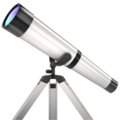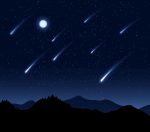![[Perseid Meteor Shower]](https://riverhouses.org/wp-content/uploads/2022/08/shooting-star-emoji.png) The annual Perseid meteor shower peaks each year around the 11th, 12th, and 13th of August — that will be next Monday through Wednesday nights. Be sure to take your young astronomers out for a look!
The annual Perseid meteor shower peaks each year around the 11th, 12th, and 13th of August — that will be next Monday through Wednesday nights. Be sure to take your young astronomers out for a look!
➤ Lunar light: The best nights for stargazing in any given month are the nights near the new moon, because that’s when the sky is darkest overall. Around the time of the full moon the sky fills with reflected lunar light and dimmer objects — whether stars or meteors — are much harder to see. This year’s Perseids will unfortunately be appearing just two or three days after a full moon, so viewing may not be the best. But it’s always worthwhile to take a look, even when conditions are not ideal. If you’re stuck with a bright moon, do this: find a location without any additional artificial lighting and position yourself so that the moon is behind a building or a tree. Give your eyes plenty of time to adjust to the darkness — at least 10 minutes — and be sure not to look at the moon or any other bright object (including your phone), because that will instantly ruin your night-adjusted vision. Then gaze away. The night sky is always full of wonders, bright moon or no, and any time you spend under it with your homeschool students will be time well spent. 🌠
The best place to check for basic Perseid meteor shower facts and local observing times is the helpful timeanddate.com website (be sure to enter your city or zipcode for specific details):
Individual Perseids may leave a short streak or may cross the entire sky, but they will all appear to radiate from the direction of the constellation Perseus, which rises in the northeast about 11 p.m. at this time of year. Your Backyard Guide to the Night Sky has handy charts that will help you orient yourself to the sky overhead.
Meteor showers like the Perseids occur when the earth in its orbit around the sun passes through the trail of debris left behind by a comet making its orbit around the sun (that’s why they occur at the same time each year). In the case of the Perseids, the parent comet involved is Comet Swift–Tuttle, which orbits the sun once every 133 years. (It last came through the inner solar system in 1992.) You and your students can learn all about meteors and meteor showers in general on the website of the American Meteor Society — here are some of their resources:
- ➢ Meteor Showers – Introduction (amsmeteors.org)
- ➢ Meteor Showers – Frequently Asked Questions (amsmeteors.org)
- ➢ Meteor Shower Calendar (amsmeteors.org)
The AMS also has a printable color poster of basic meteor terminology — it’s just the thing for your homeschool bulletin board!
![[Free Meteor Poster]](https://riverhouses.org/wp-content/uploads/2018/11/meteor-terminology-728x1024.jpg)
There is a remarkable interactive animation of the Perseid meteor shower and its parent comet available from the website meteorshowers.org. Until quite recently, interactive animations of this kind would have been available only on the most advanced computers, but now you can examine them in detail from the comfort of your little home academy.
Note that this animation is fully interactive: by dragging and scrolling across the screen you can tilt the plane of the solar system to view it from above or below, and you can zoom in on the earth’s or the comet’s orbit. (The animation begins in the outer reaches of the solar system, so you’ll have to start by zooming in to find our blue planet earth orbiting third from the sun.)
Pay a visit to a dark-sky location near your homeschool on the night of the 11th, 12th, or 13th this month, look toward Perseus, and see what shooting stars you can see.
What celestial sights and astronomical apparitions have you and your students examined in your homeschool this Hercules Term? 🔭
❡ Meteors through the year: We take special note of three meteor showers each year in the River Houses: the Leonids in November, the Geminids in December, and the Perseids in August. But there are many other smaller meteor showers that occur regularly all through the year, and they’re all worth looking for, especially if you live in a dark-sky location. The annual meteor calendars available from the American Meteor Society and timeanddate.com will help show you when and where to look for them. 🌠
❡ All the star-sown sky: Teaching your students the major constellations and the names of the principal stars is one of the simplest and most enduring gifts you can give them. Our recommended backyard star guide and homeschool world atlas both contain charts of the constellations that will help you learn your way around the heavens. Find a dark-sky spot near you this month and spend some quality homeschool time with your students beneath the starry vault. ✨
❡ Star bright: If you’d like some light and easy homeschool astronomy lessons, download and print a copy of our annual Stars & Constellations Calendar and follow along with us month by month as we make twelve heavenly friends-for-life over the course of the year. 🌟
❡ Watchers of the skies: This is one of our regular Homeschool Astronomy posts. Subscribe to our free River Houses newsletter to get more great homeschool teaching ideas delivered right to your mailbox every week. 🔭
❡ Homeschool calendars: We have a whole collection of free, printable, educational homeschool calendars and planners available on our main River Houses calendar page. They will help you create a light and easy structure for your homeschool year. Give them a try today! 🗓
❡ Support our work: If you enjoy our educational materials, please support us by starting your regular Amazon shopping from our very own homeschool teaching supplies page. When you click through from our page, any purchase you make earns us a small commission at no extra cost to you. Thank you for helping us to keep going and growing! 🛒
❡ Join us! The aim of the River Houses project is to create a network of friendly local homeschool support groups — local chapters that we call “Houses.” Our first at-large chapter, Headwaters House, is now forming and is open to homeschoolers everywhere. Find out how to become one of our founding members on the Headwaters House membership page. 🏡



